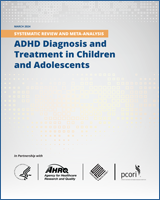| KQ2
school intervention vs control | Behavior | 3 RCTs238,
433,
531 | Conflicting results, no meaningful summary estimate could be derived (SMD −0.01; CI −1.38, 1.36; 2 studies, n=395) | C | Insufficient |
| KQ2
school intervention vs control | Broadband measures | 0 studies | No data | C | Insufficient |
| KQ2
school intervention vs control | ADHD symptoms | 6 RCTs208,
259,
529,
531,
577,
640 | No systematic effect (SMD −0.50; CI −1.05, 0.06; 5 studies, n=822) | I | Low for no benefit |
| KQ2
school intervention vs control | Functional impairment | 2 RCTs208,
259 | Conflicting results, no meaningful summary estimate could be derived (SMD 0.22; CI −4.39, 4.82; 2 studies; n=274) | C | Insufficient |
| KQ2
school intervention vs control | Acceptability of treatment | 1 RCT163 | Studies reported favorable results, but effect could not be estimated | I | Insufficient |
| KQ2
school intervention vs control | Academic performance | 5 RCTs163,
238,
259,
529,
531 | No systematic effect (SMD −0.19; CI −0.48, 0.09; 5 studies, n=854) | I | Low for no benefit |
| KQ2
school intervention vs control | Appetite suppression | 0 studies | No data | C | Insufficient |
| KQ2
school intervention vs control | Participants with adverse events | 0 studies | No data | C | Insufficient |
